Maytag LSG7806AAE, LSG7806ABQ, LSG7806AAM, LSG7806ABM, LSG7806ABE User Manual
...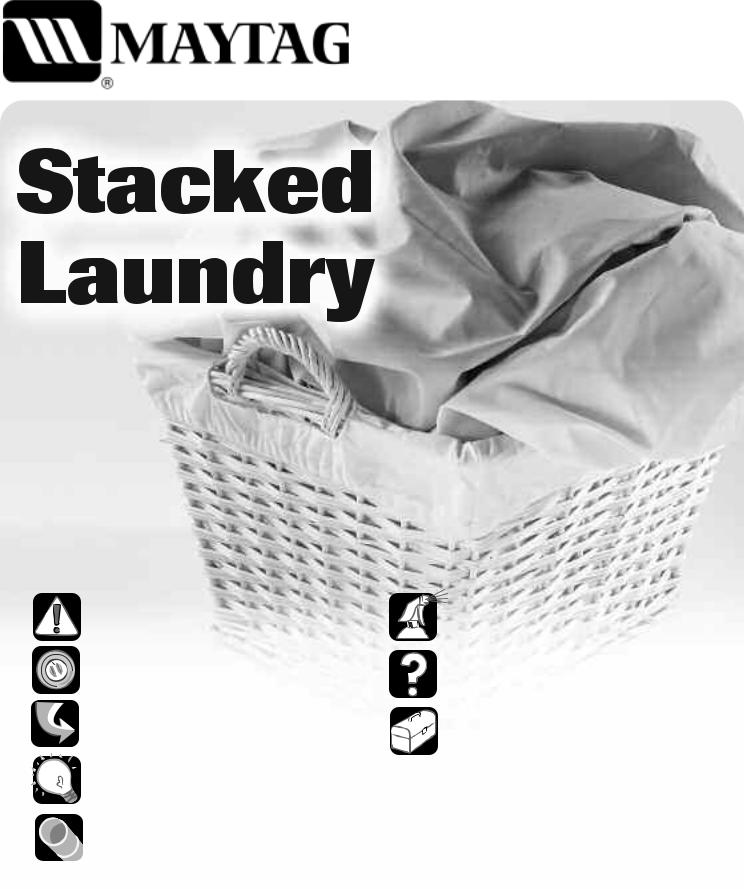
Use & Care Guide
Table of Contents
Important Safety |
|
|
Care & Cleaning . . . . . . |
. . . . . 11 |
Instructions |
1-3 |
|
Troubleshooting |
12-13 |
|
||||
|
||||
Using the Controls |
|
|
||
|
|
|
|
|
Washer . . . . . . . . . . . . . . . . . . |
4-5 |
|
|
|
Dryer . . . . . . . . . . . . . . . . . . . . |
. .8 |
|
Service & Warranty . . . |
. . . . . 15 |
Special Features . . . . . . . . . . . |
. 6 |
|
Guide d’utilisation |
|
|
|
|
et d’entretien . . . . . . . . . |
. . . . . 16 |
Operating Tips |
|
|
|
|
Washer . . . . . . . . . . . . . . . . . . |
. .7 |
|
Guía de uso y cuidado |
. . . . . 34 |
Dryer . . . . . . . . . . . . . . . . . . . . |
. .9 |
|
|
|
Dryer Exhaust Tips . . . . . . . . |
.10 |
|
|
|
Y81921 A |
Part No. 2206689 |
www.maytag.com |
Litho U.S.A. |
©2006 Maytag Appliances Sales Co. |



 Important Safety Instructions
Important Safety Instructions
Installer: Please leave this guide with this appliance.
Consumer: Please read and keep this guide for future reference. Keep sales receipt and/or canceled check as proof of purchase.
Model Number _______________________________
Serial Number ________________________________
Date of Purchase ______________________________
If you have questions, call:
Customer Assistance
1-800-688-9900 U.S.A.
1-800-688-2002 Canada (Mon.-Fri., 8am-8pm Eastern Time) Internet: http://www.maytag.com
U.S. Customers using TTY for deaf, hearing impaired or speech impaired, call 1-800-688-2080.
In our continuing effort to improve the quality and performance of our appliances, it may be necessary to make changes to the appliance without revising this guide.
For service information, see page 15.
What You Need to Know About Safety Instructions
Warning and Important Safety Instructions appearing in this guide are not meant to cover all possible conditions and situations that may occur. Common sense, caution and care must be exercised when installing, maintaining or operating appliance.
Always contact the manufacturer about problems or conditions you do not understand.
Recognize Safety Symbols, Words,
Labels
 WARNING
WARNING
WARNING – Hazards or unsafe practices which COULD result in severe personal injury or death.
 CAUTION
CAUTION
 WARNING! FIRE HAZARD
WARNING! FIRE HAZARD
Do not add gasoline, dry-cleaning solvents, or other flammable or explosive substances to the wash water. These substances give off vapors that could ignite or explode.
Do not wash articles which have been previously cleaned, washed, soaked, or spotted with gasoline, dry-cleaning solvents, oil, waxes, chemical solvents, alcohol, turpentine, or other flammable or explosive materials. These substances will be retained in articles, and articles which still contain these flammable or explosive substances give off vapors that could ignite or explode.
Observe these precautions when using cleaning fluids, spot or stain removers, etc. These products should be labeled “nonflammable.” Use according to manufacturers directions in a well ventilated area or outdoors. Thoroughly rinse articles by hand before placing them in the washer. Some of these products
– rust removers for example – will damage components and the finish of the washer.
Keep area around and underneath washer free from the accumulation of combustible materials, such as lint, paper, rags, gasoline, and all other flammable vapors and liquids.
HYDROGEN GAS IS EXPLOSIVE! Under certain conditions, hydrogen gas may be produced in a hot water system that has not been used for two weeks or more. If the hot water system has not been used for such a period, before using the washer, turn on all the hot water faucets and let the water flow from each faucet for several minutes. This will release any accumulated hydrogen gas. As this gas is flammable, do not smoke or use an open flame during this time.
Recent studies have shown that if vegetable oil contaminated materials are incompletely washed, a carry-over and buildup of the oil may contribute to a chemical reaction (spontaneous combustion) that could cause a load to catch fire by itself. This would be more likely to happen if the load were left in the dryer after tumbling stopped or if items were folded and stacked while warm.
CAUTION – Hazards or unsafe practices which COULD result in minor personal injury.
1



 Important Safety Instructions
Important Safety Instructions
 WARNING
WARNING
For your safety, the information in this guide must be followed to minimize the risk of fire or explosion or to prevent property damage, personal injury or death.
•Do not store or use gasoline or other flammable vapors and liquids in the vicinity of this or any other appliance.
WHAT TO DO IF YOU SMELL GAS
•Do not try to light any appliance.
•Do not touch any electrical switch.
•Do not use any phone in your building.
•Clear the room, building or area of all occupants.
•Immediately call your gas supplier from a neighbor’s phone. Follow the gas supplier’s instructions.
•If you cannot reach your gas supplier, call the fire department.
Installation and service must be performed by a qualified installer, service agency or the gas supplier.
 WARNING! FIRE HAZARD
WARNING! FIRE HAZARD
Do not place into your dryer items that have been spotted or soaked with vegetable oil or cooking oil. Even after being washed, these items may contain significant amounts of these oils. The remaining oil can ignite spontaneously. The potential for spontaneous ignition increases when the items containing vegetable oil or cooking oil are exposed to heat. Heat sources, such as your clothes dryer, can warm these items, allowing an oxidation reaction in the oil to occur. Oxidation creates heat. If this heat cannot escape, the items can become hot enough to catch fire. Piling, stacking or storing these kinds of items may prevent heat from escaping and can create a fire hazard.
All washed and unwashed fabrics that contain vegetable oil or cooking oil can be dangerous. Washing these items in hot water with extra detergent will reduce, but will not eliminate, the hazard. Always use the Cool Down cycle for these items to reduce the items’ temperature. Never remove these items from the clothes dryer hot or interrupt the drying cycle until the items have run through the Cool Down cycle. Never pile or stack these items when they are hot.
Important Safety
Notice & Warning
The California Safe Drinking Water and Toxic Enforcement Act of 1986 (Proposition 65) requires the Governor of California to publish a list of substances known to the State of California to cause cancer or reproductive harm, and requires businesses to warn customers of potential exposures to such substances.
Users of this appliance are hereby warned that the burning of gas can result in low–level exposure to some of the listed substances, including benzene, formaldehyde, and soot, due primarily to the incomplete combustion of natural gas or liquid petroleum (LP) fuels. Exhaust ducts should be kept free of obstructions and properly exhausted dryers will minimize exposure.
 WARNING
WARNING
Gas leaks may occur in your system and result in a dangerous situation. Gas leaks may not be detected by smell alone. Gas suppliers recommend you purchase and install an UL approved gas detector. Install and use in accordance with the manufacturer's instructions.
Note: Because of continuing product improvements, Maytag reserves the right to change specifications without notice. For complete details, see the Installation Instructions packed with your product before selecting cabinetry, making cutouts or beginning installation.
Cont.
2



 Important Safety Instructions
Important Safety Instructions
 WARNING
WARNING
To reduce the risk of fire, explosion, electric shock, or personal injury when using your washer, follow basic safety precautions, including the following:
1.Read all instructions before using the appliance.
2.To avoid the possibility of fire or explosion:
a.Do not wash or dry items that have been previously cleaned in, washed in, soaked in, or spotted with gasoline, dry-cleaning solvents, other flammable or explosive substances as they give off vapors that could ignite or explode. Hand wash and line dry any items containing these substances.
Any material on which you have used a cleaning solvent, or which is saturated with flammable liquids or solids, should not be placed in the appliance until all traces of these liquids or solids and their fumes have been removed.
These items include acetone, denatured alcohol, gasoline, kerosene, some liquid household cleaners, some spot removers, turpentine, waxes and wax removers.
b.Do not add gasoline, dry-cleaning solvents, or other flammable or explosive substances to the wash water. These substances give off vapors that could ignite or explode.
c.Under certain conditions, hydrogen gas may be produced in a hot water system that has not been used for 2 weeks or more. HYDROGEN GAS IS EXPLOSIVE. If the hot water system has not been used for such a period, before using a washing machine or combination washer-dryer, turn on all hot water faucets and let the water flow from each for several minutes. This will release any accumulated hydrogen gas. As the gas is flammable, do not smoke or use an open flame during this time.
d.Items containing foam rubber (may be labeled latex foam) or similarly textured rubber-like materials must not be dried on a heat setting. Foam rubber materials when heated, can under certain circumstances produce fire by spontaneous combustion.
e.Do not wash or dry items that are soiled with vegetable or cooking oil. These items may contain some oil after laundering. Due to the remaining oil, the fabric may smoke or catch fire by itself.
3.Do not allow children to play on or in the appliance. Close supervision of children is necessary when the appliance is used near children.
4.Before the appliance is removed from service or discarded, remove the door to the clothes washer compartment.
5.Do not reach into the appliance if the tub, agitator, or drum is moving.
6.Do not install or store this appliance where it will be exposed to the weather.
7.Do not tamper with controls.
8.Do not repair or replace any part of the appliance or attempt any servicing unless specifically recommended in published user-repair instructions that you understand and have the skills to carry out.
9.The agitator should not be removed. If the agitator is removed, it must be replaced by pushing down completely and the locking screw tightened before the washer is operated.
10.Do not use fabric softeners or products to eliminate static unless recommended by the manufacturer of the fabric softener or product.
11.Clean the dryer lint screen before or after each load.
12.Keep the area around the exhaust opening and surrounding areas free from lint accumulation, dust and dirt.
13.The interior of the dryer and exhaust duct should be cleaned periodically by qualified service personnel.
14.This appliance must be properly grounded. Never plug the appliance cord into a receptacle which is not grounded adequately and in accordance with local and national codes. See Installation Instructions for grounding this appliance.
15.Unplug power supply cord before attempting to service your appliance.
16.Store laundry aids and other material in a cool, dry place where children cannot reach them.
17.Do not use chlorine bleach and ammonia or acids (such as vinegar or rust remover) in the same wash. Hazardous fumes can form.
18.Do not machine wash fiberglass materials. Small particles can stick to fabrics washed in following loads and cause skin irritation.
19.Before the appliances are removed from service or discarded, remove the door to the clothes dryer compartment.
20.Install and level appliance on a floor that can support the weight.
21.As with any equipment using electricity and having moving parts, there are potential hazards. To use this appliance safely, the operator should become familiar with the instructions for operation of the appliance and always exercise care when using it.
SAVE THESE INSTRUCTIONS
3

 o
o
4
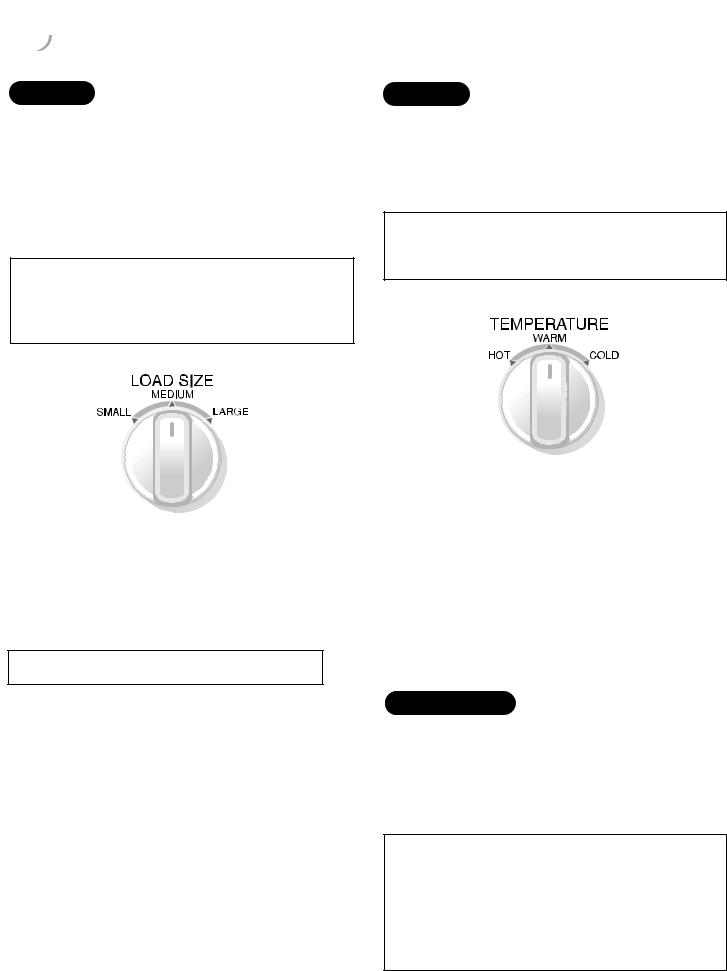


 Using the Controls – Washer
Using the Controls – Washer
STEP 2 |
|
STEP 3 |
|
|
|
Select Load Size
Turn the LOAD SIZE knob to the SMALL, MEDIUM, or LARGE setting.
For best washing results, clothes must circulate freely. If too little water is used, poor cleaning, linting, and excessive wear may result.
Note: When laundering permanent press items, delicates, washable woolen or loosely knit items, never use less than the MEDIUM setting. This will minimize shrinkage, wrinkling, and pulling of seams.
Select Water Temperature
Turn the TEMPERATURE knob to the desired water temperatures. Follow the garment care label for best results. Use the chart below as a guide.
Note: In wash water temperatures below 60º F, detergents do not dissolve well or clean well. Care labels define cold water as up to 85º F.
WATER LEVEL SETTING |
|
|
LOAD SIZE |
|
|
|
|
Large |
|
|
3/4 – Full |
|
|
|
|
Medium |
|
|
1/3 – 3/4 Full |
|
|
|
|
Small |
|
|
1/3 Full |
|
|
|
|
Items must circulate freely for best results.
WASH/RINSE TEMPS |
|
|
LOAD TYPE |
|
|
|
|
Hot/Cold |
|
|
White and heavily |
|
|
soiled, color-fast items. |
|
|
|
|
|
|
|
|
|
Warm/Cold |
|
|
Moderately soiled, |
|
|
colored items; most |
|
|
|
|
|
|
|
|
permanent press items. |
|
|
|
|
Cold/Cold |
|
|
Brightly colored, lightly |
|
|
soiled items; washable |
|
|
|
|
woolens. |
|
|
|
|
STEP 4
Start Washer
•Add detergent.
•Add laundry load and close lid.
•Pull out control dial to start.
Note: The washer is automatically programmed to assure proper agitation and spinning for each load type. REGULAR FABRICS will provide a fast wash/spin speed. PERMANENT PRESS will have a fast wash/spin speed along with a cool-down spray rinse. KNITS/DELICATES will have alternating periods of wash and soak and fast final spin speed.
5

use,
using
This
. It
.
Pour liquid chlorine bleach into the bleach dispenser.
Pour liquid fabric softener into cup and dilute with warm water.
6
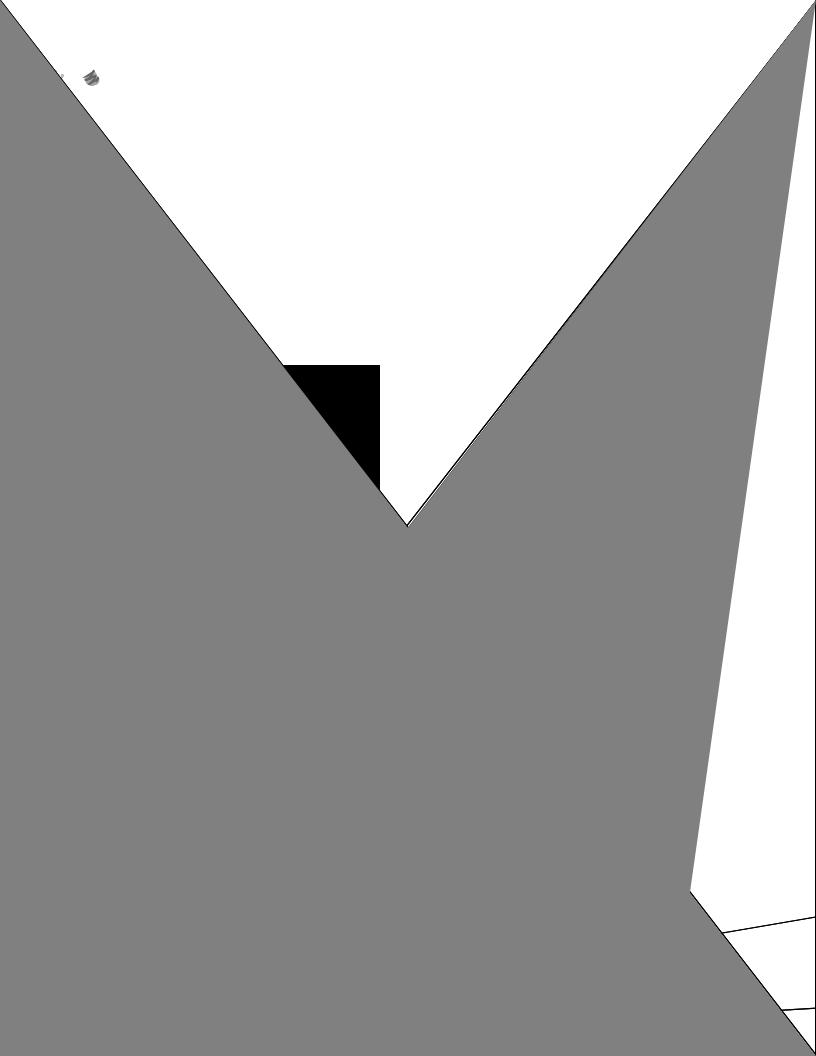




 Operating Tips - Washer
Operating Tips - Washer
Detergent
•Use either liquid or granular laundry detergent. For best results, be sure detergent is added to the washer BEFORE the load and be sure wash water is above 60º F.
•Use the correct amount of detergent for the load size, soil level and water conditions. Use more detergent if you have hard water and very soiled loads.
If you have soft water or a lightly soiled load, use less detergent. (See manufacturer’s instructions.)
•Wipe up any detergent spills on the washer.
Loading
•Put dry, unfolded clothes loosely in the tub, up to the top row of holes for a maximum load.
•Do not wrap large items like sheets around the agitator.
•Mix large and small items for best circulation. Wash bulky items like blankets separately.
•When laundering permanent press items or items of delicate construction, washable woolens or loosely knit items, never use less than the MEDIUM water level setting. This will minimize shrinkage, wrinkling and pulling of seams.
•For best results, add the detergent to the washtub before adding the load.
7
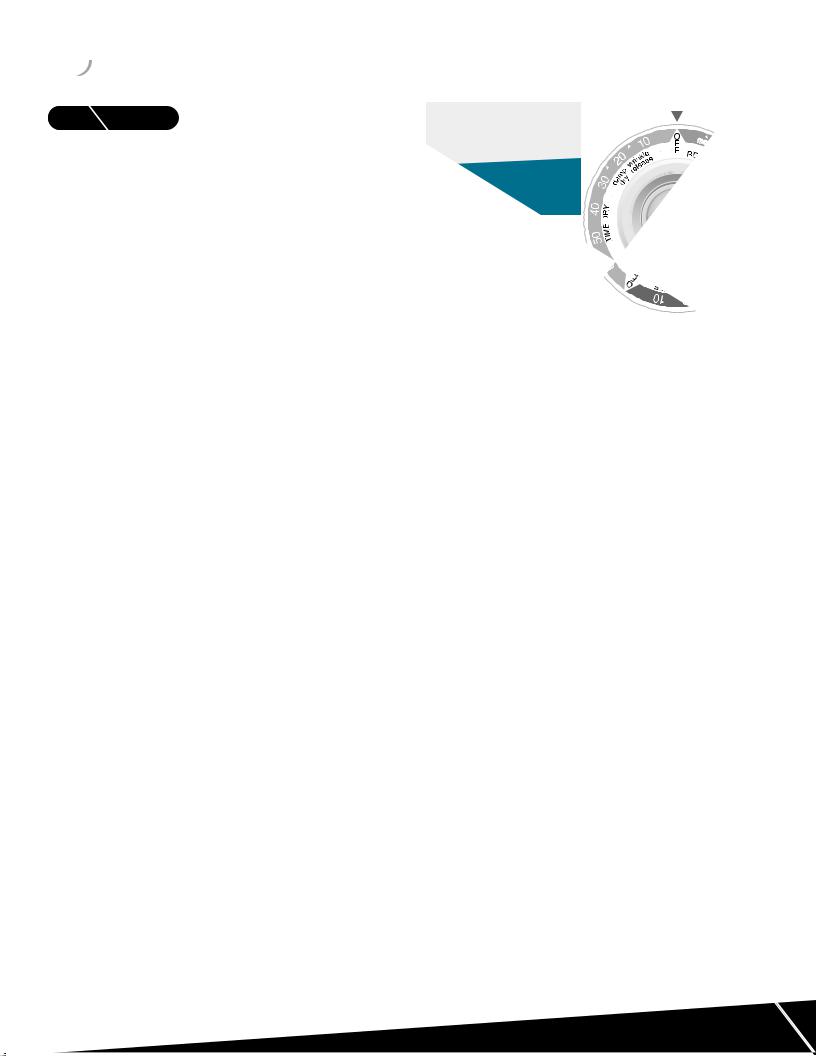
 Using the Controls – Dryer
Using the Controls – Dryer
STEP 1
Select Cycle
WRINKLE RELEASE will release wrinkles from items that are clean and dry but slightly wrinkled. This cycle is for clothes from a crowded closet or suitcase or from sitting in the dryer too long after the end of the cycle. It provides 10 minutes of heated tumbling and 5 minutes of cool-down tumbling without heat. Press the START button for the cycle to begin.
DAMP DRY is designed to “partially” dry items. It provides approximately 20 minutes of heated tumbling and 5 minutes of cool-down tumbling without heat. Press the START button to begin tumbling.
TIME DRY may be selected for any load if the IntelliDry sensor system is not desired. Set the control to the desired number of minutes and choose the appropriate drying temperature for the load. Then press the START button.
AIR FLUFF provides tumbling without heat for sensitive loads or items needing freshening. Examples are: certain sweaters, shower curtains, camping gear, pillows, etc. Set the control to the desired number of minutes, up to 20 minutes, and press the START button.
IntelliDry PERM’T PRESS with Press Care automatically senses the moisture in the load and shuts off when the selected dryness level is reached. Permanent Press minimizes wrinkles of man-made fabrics such as acrylic, nylon, polyester, or blends with an extended cool-down by tumbling the load in unheated air at the end of the cycle. Simply set the control to the desired dryness level (more dry – less dry) and press the START button. The middle ▲ is the initial preferred setting for the majority of loads.
IntelliDry REGULAR FABRICS automatically senses the moisture in the load and shuts off when the selected dryness level is reached. This cycle is designed for loads such as towels, underwear, t-shirts, jeans, etc. Set the control to the desired dryness level (more dry – less dry) and press the START button. The middle ▲ is the initial preferred setting for the majority of loads.
8
WhenbuttonPSTEPTARTressEP |
ush theStartmus |
this cyclbe |
buttonpushedagainis |
3 |
tocomplete, to |
st |
a resume |
2 |
signal the |
will cycle |
sound once |
the |






 Dryer Operating Tips
Dryer Operating Tips
Clean the
Lint Filter...
• after each load.
• to shorten drying time.
• to operate more energy efficiently. 
Note: Do not operate the dryer without the lint filter in place.
Add A Fabric Softener Sheet...
(If so desired)
•after loading the dryer.
•to control static cling.
•before the load becomes warm. This helps prevent greasy–looking softener stains.
•and remove any used softener sheets from the dryer to prevent greasy–looking softener stains.
Load the Dryer Properly...
•Place only one washload in the dryer at a time.
•Mixed loads of heavy and lightweight clothes will dry differently. Lightweight clothes will dry, while heavy clothes may be damp.
•Add one or more similar items to the dryer when only one or two articles need drying. This improves the tumbling action and drying efficiency.
•Overloading restricts tumbling action, resulting in uneven drying as well as excessive wrinkling of some fabrics.
•When drying large, bulky items such as a blanket, it may be necessary to reposition the load during the cycle to ensure even drying.
9
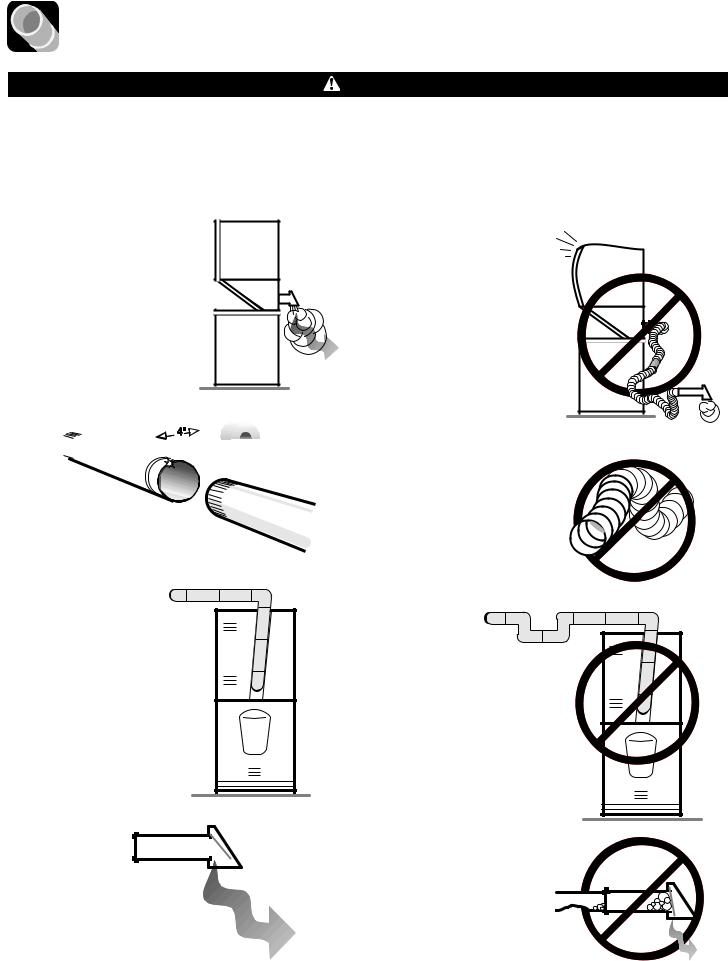
|
Dryer Exhaust Tips |
|
cause slow drying. |
|
|
|
|
|
WARNING |
|
|
|
Plastic or nonmetal flexible duct presents a potential fire hazard. |
|
|||
|
|
|
|||
DO |
DON’T |
|
|||
|
|
|
|
|
|
|
Read the Installation Instructions |
|
|
Let a poor exhaust system |
|
|
and the Use and Care Guide. |
|
|
|
|
|
|
|
|
|
|
DO
Let your dryer exhaust the air easily.
DO 


Use 4 inch diameter rigid  metal duct. Tape all joints, including at the dryer.
metal duct. Tape all joints, including at the dryer.
Never use lint-trapping screws.
DON’T
Restrict your dryer with a poor exhaust system.
DON’T
Use plastic, thin foil, or non-metal flexible duct.
DO
Keep duct runs as straight as possible.
DO
Clean all old ducts before installing your new dryer. Be sure vent flap opens and closes freely. Inspect and clean the exhaust system annually.
DON’T
Use longer than necessary duct runs with many elbows.
DON’T
Allow crushed or clogged ducts and vent.
10



 Care & Cleaning
Care & Cleaning
Control Panel Care
Clean the control panel with a soft damp cloth. Do not use any abrasive powders or cleaning pads.
Cabinet Care
Simply wipe off any marks with soap and water. Use an appliance wax once a year if desired.
Your appliance should not be installed where temperatures will go below freezing, as damage to the washer could result.
Remove pins, buckles or other sharp objects from clothes to prevent scratching interior parts.
Bleach, detergent, solvents, etc. spilled on the top of your washer that are allowed to remain will remove the glossy finish. Remove all spills with a damp, soft cloth.
Do not lay heavy or sharp objects on top of your washer.
The top of the washer should not be used for removing stains from garments. Some stain removers, such as rust remover, will mar the finish.
Washer Care
Lint Filter
The SELF-CLEAN LINT FILTER in the washer is located under the agitator and cleans itself. During the wash and rinse portion of the cycle, lint is collected on the filter. The filter is then flushed automatically during the spin and drain.
Cleaning the Interior
Clean the interior of the washer periodically to remove any dirt, soil, odor, mold, mildew or bacteria residue that may remain in the washer as a result of washing clothes. We recommend taking the following steps every 60 to 120 days to clean and freshen your washer interior. The frequency with which the washer should be cleaned and freshened depends on factors such as usage, the amount of dirt, soil or bacteria being run through your washer, or the use of cold water. Failure to follow these instructions may result in unsatisfactory conditions, including unpleasant odor and/or permanent stains on the washer or washload.
To clean and freshen the washer interior:
1.Add a measured amount of chlorine bleach to the bleach dispenser, following package directions.
2.Add 1/4 cup of detergent to the tub.
3.Run the washer without a load through a complete cycle using hot water.
4.Repeat the process if necessary.
Dryer Care
Tumbler
Remove any stains such as crayon, ink pen or fabric dye from new items (such as towels or jeans) with an all-purpose cleaner. Then tumble old towels or rags to remove any excess stain or cleaning substance. Once these steps are done, stains may still be visible, but should not transfer to subsequent loads.
Exhaust System Cleaning
Inspect and clean once a year to maintain optimum performance. The outside exhaust hood should be cleaned more frequently to ensure proper operation. (Refer to the Installation Instructions for more information.)
Storing the Appliance
If you close your home for the winter, have a service technician drain the washer. Unplug cord from electrical outlet and disconnect hoses from faucets.
Note: For extended periods of storage or storage during extreme cold temperatures, call Maytag Customer Service in the U.S. at 1-800-688-9900 or in Canada at 1-800-688-2002.
11



 Troubleshooting
Troubleshooting
Check these points if your clothes washer...
Won’t Fill |
• |
Plug cord into live electrical outlet. |
|
|
• |
Check fuse or reset circuit breaker. |
|
|
• |
Close lid, turn the control dial to proper cycle and restart the washer. |
|
|
• |
Turn both faucets on fully. |
|
|
• |
Straighten inlet hoses. |
|
|
• |
Disconnect hoses and clean screens. Hose filter screens may be plugged. |
|
Won’t Agitate |
• |
Check fuse or reset circuit breaker. |
|
|
• |
Make sure the lid is completely closed. |
|
|
• |
Turn the control dial to proper cycle and restart the washer. |
|
|
• |
Pauses are normal. Wait and see if the washer will start again. |
|
Won’t Spin |
• |
Check fuse or reset circuit breaker. |
|
|
|
||
or Drain |
• |
Straighten drain hoses. Eliminate kinked hoses. If there is a home drain restriction, call for |
|
|
|
drain service. |
|
|
• |
For your safety, washer will not spin unless the lid is closed. Close lid and restart the washer. |
|
|
• |
Suds lock – caused by too much suds. Rewash without detergent. Use correct amount of a |
|
|
|
low-sudsing detergent. |
|
|
• Unevenly distributed load. Redistribute the load, close the lid and pull knob out. Check for leveling. |
||
|
|
Be sure water level is acceptable for load size. |
|
|
|
|
|
Stops |
• |
Unevenly distributed load. Redistribute the load, close the lid and pull knob out. Check for leveling. |
|
|
|
Be sure water level is acceptable for load size. |
|
|
• Plug cord into live electrical outlet. |
||
|
• Check fuse or reset circuit breaker. |
||
|
• Turn the control knob to proper cycle and pull knob out to start the washer. If equipped with buttons, |
||
|
|
be sure they are fully depressed. |
|
|
• Close lid and pull control knob out to start the washer. For your safety, washer will not fill, agitate |
||
|
|
or spin unless lid is closed. |
|
|
• This may be a pause or soak period in the cycle. Wait briefly and it may start |
||
Leaks Water |
• |
Make sure hose connections are tight. |
|
|
• |
Make sure end of drain hose is correctly inserted and secured to drain facility. |
|
|
• |
Avoid extended soaking – soak for 30 minutes or less. |
|
|
• |
Avoid overloading. |
|
Is Noisy |
• |
Be sure washer is leveled properly as outlined in installation manual. |
|
|
• |
Weak floors can cause vibration and walking. |
|
|
• |
Operating sounds will vary depending on agitation speed. |
|
|
|
|
|
Fills with |
• |
Turn both faucets on fully. |
|
the Wrong |
• |
If equipped with a temperature selector dial, be sure it is set directly on a temperature setting and |
|
Temperature |
|||
|
not between settings. |
||
Water |
|
||
• |
Make sure temperature selection is correct. |
||
|
|||
|
• |
Make sure hoses are connected to correct faucets and inlet connections. Be sure water supply is |
|
|
|
regulated correctly. Flush water line before filling washer. |
|
|
• |
Check the water heater. It should be set to deliver a minimum 120° F (49° C) hot water at the tap. |
|
|
|
Also check water heater capacity and recovery rate. |
|
|
• |
Disconnect hoses and clean screens. Hose filter screens may be plugged. |
|
|
|
|
|
Load is Wet |
• |
Unevenly distributed load. Redistribute the load, close the lid and restart the washer. Check for |
|
|
|
leveling. Be sure water level is acceptable for load size. |
|
For further assistance, call Maytag Customer Assistance toll-free at 1-800-688-9900 USA or 1-800-688-2002 Canada. U.S. customers using TTY for deaf, hearing impaired or speech impaired, call 1-800-688-2080.
12



 Troubleshooting
Troubleshooting
Check these points if your clothes dryer...
Doesn’t Run |
• |
Be sure the door is shut. |
|
|
• Be sure the power cord is plugged into a live electrical outlet. |
||
|
• Check the home’s circuit breaker and fuses. |
||
|
• Press the START button again if the door is opened during the cycle. |
||
Doesn’t Heat |
• |
Check fuse or reset circuit breaker. |
|
• |
Select a heat setting, not air fluff. |
||
|
|||
|
• |
Check that the gas supply is on for gas dryers. |
|
|
• |
Clean the lint filter and exhaust duct. |
|
|
|
||
Doesn’t Dry |
Check all of the above, plus... |
||
Properly |
• |
Check the exhaust hood outside the house, make sure it opens and closes freely. |
|
|
|||
|
• |
Check exhaust system for lint buildup. Ducting should be inspected and cleaned annually. |
|
|
• |
Use rigid 4” metal exhaust duct. |
|
|
• |
Do not overload. 1 wash load = 1 dryer load. |
|
|
• |
Sort heavy items from lightweight items. |
|
|
• |
Large, bulky items like blankets or comforters may require repositioning to ensure even drying. |
|
|
• |
Check the washer to be sure it is draining properly to extract water from the load. |
|
|
• |
Clothes load is too small to tumble properly. Add a few towels. |
|
|
• |
Check the load for objects such as coins, nails, etc. Remove promptly from dryer. |
|
Is Noisy |
• |
It is normal to hear the dryer gas valve or heating element cycle on and off during the drying cycle. |
|
|
• |
The dryer should be level and installed on a solid floor. |
|
|
• |
A clicking noise may be the timer advancing. |
|
|
• |
It is normal for the dryer to hum due to the high velocity of air moving through the dryer drum and |
|
|
|
exhaust system. |
|
Control Knob |
• |
This is normal operation for an IntelliDry cycle, especially at the beginning of cycle. Once the load |
|
Advances Slowly |
|
begins to dry, the control knob will start to advance. The rate of advancement will be slow at the |
|
|
|
beginning of the cycle because there is more moisture in the load. As the load becomes more dry, |
|
|
|
the control knob will advance more quickly. |
|
Dries Unevenly |
• |
Seams, pockets and other similar heavy areas may not be completely dry when the rest of the load |
|
|
|
has reached the selected dryness level. This is normal. Select the IntelliDry, more setting if desired. |
|
|
• If one heavy item is dried with a lightweight load, such as one towel with sheets, it is possible that |
||
|
|
the heavy item will not be completely dry when the rest of the load has reached the selected |
|
|
|
dryness level. Sort heavy items from lightweight items for best drying results. |
|
|
|
|
|
Has an Odor |
• |
Household odors such as from painting, varnishing, strong cleaners, etc. may enter the dryer with |
|
|
|
the surrounding room air. This is normal as the dryer draws the air from the room, heats it, pulls it |
|
|
|
through the tumbler and exhausts it to the outside. When these odors are present in the air, |
|
|
|
ventilate the room completely before using the dryer. |
|
|
|
|
|
13



 Notes
Notes
14
